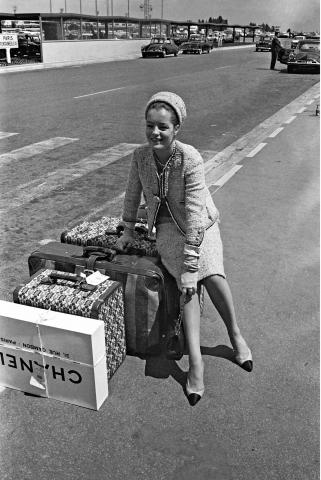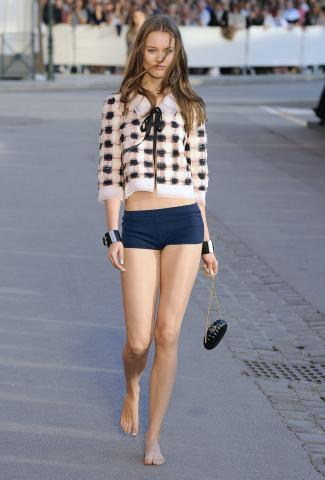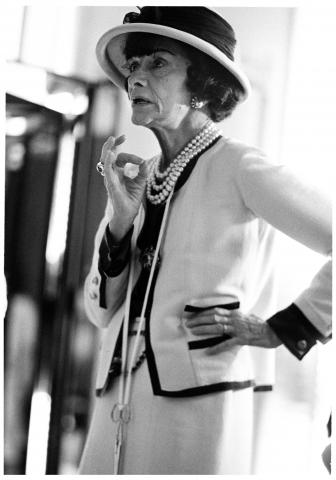CHANEL Les secrets de la Veste
"Simplicity is the key note of all elegance" Chanel, Harpers Bizzar 1923.
I was lucky enough to be introduced to the private world of the CHANEL Atelier in Rue de Cambon and told some of the secrets of the construction of the celebrated famous jacket, in it's many forms created by Gabrielle Chanel.
Chanel wanted women to be free to enjoy their clothes and not to be constrained by them. As the pace of life changed through the course of the 20th Century so women's lives changed also.
(C) CHANEL 2010.
Above are two pieces from the 2010-2011 Cruise collection that show how the CHANEL veste has enduring popularity with clients world wide and continues to be reinvented in a myriad of ways by Karl Lagerfeld. Chic and exclusive, it never loses it's appeal. The Cruise Collection 2010 - 2011 will be available in CHANEL stores world wide from November 2010.
The lovely Pascal from CHANEL in Paris gave a step by step guide to the construction of the jacket and the deeper meanings behind many of it's composite elements.
There are many steps to creating the signature jackets and among the key features are the chains and the lining. For Chanel symbolsim was very important there is meaning in many details and there is also practicality. The chains for example give weight to the jacket so the material hangs well on the body. The chains also carry the memory of Chanel's childhood in the convent in Aubazine as the sisters used to wear chatelaine chains to carry the keys to the building. There is alos a link to the lives of poorer women who would carry keys on chains around their waists in the areas of France where she grew up. Chanel wanted her clothes to be worn by all women and certainly her influence on fashion did change women's lives. As is the case many times over with Chanel and her work, symbolism is important and symbols are repeated over and over again.
For Chanel the beauty of detail is all important. Chanel created costume jewellery so that all women could wear something beautiful. By using flowes she finds the heart of a woman's feminity. Chanel's favourite flower, the Camellia, has many different symbolic meanings. It is the symbol of eternal youth in Japanese tradition and the white of the flower also denotes the purity of the spirit.
The Camellia also has a special significance as a link to her relationship with the Boy Capel. This white flower symbolises eternal youth and corresponds with the popular taste for Japonais at the time that Chanel founded the House. What fascinates me is the combination of elements and influences that created the jacket. The masculine influence of practicality from the clothes worn by Boy Capel and Balsan and the memory of the uniforms of the soldiers garrisoned at Saumur that Chanel saw in her early life. Chanel wanted women to be strong and independant through their clothes, as free as men were to move when walking, or riding.
While undoubtedly Balsan and Capel gave her support, it was her ideas, her drive and her vision that created an Empire that spaned the globe. Chanel's message is that clothes must be practical, style is forever chic. This was a marked contrast with the earlier clothes of the late Edwardian era that had been produced by Paris' early Couture Houses Paul Poiret and Worth. Chanel wanted to break free from the past.
Through studying the wardrobes of Balsan and Boy, Chanel found the advantages of mens tailoring and through the companions of these men she understood what women who patronised the Couture Salons of Paris wanted. Chanel began to see these women dressed as dolls, corsetted and restrained. She herself apprantly gave up corsets after an evening in Paris where her fitted dress could not be refastened when she had tried to adjust it. A moment of embarrassment became a turing point for her and it is said that she never wore a corset again in her life.
In 1926 she launched the famous Little Black Dress in Jersey, the fabric of men's undergarment tailoring. Chic and confortable this dress focussed the attention on the wearer both in it's colour and simplicity. Chanel said that clothes should make you notice the person. The T-shaped black dress was also a key piece for the American market. It was a success and helped usher in the new era of simplified tailored clothes that we assocoiate with the 1930s.
Chanel always had the woman in mind. She thought about who she was and how she lived, this gave her the key to understanding how the clothes must work for her clients and become a seemless part of their day to day lives. Chanel said that "I wanted to make women feminine, to explain that you can be pretty and well dressed." For Chanel well dressed meant practical and stylish. "Nothing useless, everything has a function, no button without a button hole."
You can see this in the jackets, most have pockets for example. Chanel needed pockets for her scissors and measuring tapes and pins, the accessories of the atelier. She knew that other women where just like her. They had keys and coinpurses, cards and cigarettes to carry to hand. She was a woman who understood women's fashion had to change. Their lives where no longer based only in the Drawing Room World.
There are further mysteries in the jacket irself. For example the original method of making the braids was a complex technique that Chanel herself taught to only one or two people before she died. In the recent biography of Chanel by Justine Picardie 'Coco Chanel The Legend and the Life' she looks in great detail the sybols the appear on the buttons and how they can be traced to decorative features in Chanel's apartment in the Rue Cambon. Lions, Jade, Chinoise Coromandel screens, Crosses, Camellias, even Tarot Cards. It's all there waiting to be discovered and decoded.
I would strongly recommend reading Justine's book and checking out her web blog at http://justine-picardie.blogspot.com/. Justine has researched this book since the late 1990s and the wealth of detail it contains is testiment to her hard work and tenacity in understanding her subject. I'm sure Madamoisselle herself would strongly approve.
This desire to liberate women also gave rise to the world's most famous handbag, the Chanel 2.55 Chanel used the chains to free women's arms for practicality. The bag is a quilted for softness and also gives the material a reinforced durability. The lock was originally in the classic mademoiselle design but later employed the cypher of the interlocking C's in the 1980s. The most famous symbol of Chanel. This was again practical to protect woman's possessions and again showed that this bag was important and contained important things. Symbolism appears again the 2.55 represents the month of February 1955 when the bag was first created. There is an outside pocket that is useful to store money and inside there are secret pockets where Mademoiselle is believed to have stored her love letters. The bags are lined with red which may be linked to the colour of vestiments that where worn by the nuns in the convent where she was educated.
(C) Angela Cliffe 2009 - 2010
Beauty, Grace and Style





Symbolism is a reccuring theme in Chanel's work. The more you look and the more you know of her past, the more you can find. The famous signature scent Chanel No. 5 is a wonderful confection in symbols and meaning that where special to mademoiselle.
The scent was co-created with Ernest Beaux is widly recognised as the first modern perfume. On the presentation by Beaux to Chanel of the fragances he had created as samples this was the fifth that he placed on the table in front of her. It is composed of the fragrances of five flowers and this muti-layered effect.
To test the fragrances Chanel carefully sprayed each one by one under the table of the restaurant where they met and awaited the reaction of the ladies who where dining around them. This fifth perfume was the one that made heads turn. This was the one.
It was important for the signature fragrance of the House to embody every aspect that Chanel herself belived was chic and represented good taste. The stopper in the top is a replica of the shape of the Place de Vendome. The true heart of Paris and the beating heart of Parisienne Haute Couture. My last visit their in Haute Couture week in July'10 was a wonderful experience. This really is the heart of Paris where you meet the most wonderful people. I know why she loved it so much. Chanel also lived at the Ritz in one side of the Place that faces across to the Rue Cambon and her Atelier on it's other side. The cord around the stopper is a representation of the necklaces made by Chanel that draped and wrapped around the neck (as worn by Keira Knightly in the Coco Mademoiselle mini - film advertorials - and also my favourite fragrance) and may also be an echo the Chanel chains. Even the stoppers of the purfume bottles have a seal with the impression of the Camellia.
It is another example of how things seemed to fall into place for Chanel when she followed her instincts and supersticions. I must also mention that there is another extraordianry figure in the history of Chanel No. 5 that you may not know of. Chanel was good friends with Prince Dimitri Romanov who lived in Paris with his sister Princess Marie Pavlovana who owned a fashion business called Kitmir. Princess Marie was very famous for her embroidery and Chanel went to her atelier at Kitmir to learn from her.
Many other Russian aritstocratic women had also turned their hand to business ventures in Paris after the Revolution. It was through Dimitri and Marie that Chanel was introduced to Ernest Beaux. Dimitri and his family including the dowager Empress of Russia where kind to Chanel and supported her talent. In a strange way both Chanel and Dimitri had left their origins behind them and where working hard to create a new life. They both also travelled relentlessly and where eager to discover new things. They may have been from different backgrounds but their's seems to have been a meeting of minds.
Today embroidery at Chanel however has continued under the guidance of the Metieur Atelier of Monsieur Lesage. His family owned company provide up to 100 hundred pieces of embroidery for each to the Haute Couture shows. Karl Lagerfeld knows that his designs are in the safest of hands with this house, one of the oldest in Paris. Lesage is one of several Houses that specialise in creating various specialties that the world of Haute Couture relies upon.
Again we see that the spirit of Chanel never rests the House pursues quality and perfection in her name as she sleeps.
In 2002 Chanel brought several of these Houses into their family and celebrated the creation of the Metiers d'arts - Desrues the costume jewellers, Lesage the embroiderers, milliner Michel, feather artisan Lemarié, cobbler Massaro, floral designer Guillet, and silversmith Goosens.
In July 2010 they showcased some of their work in Shanghai. This was to celebrate Paris-Shanghai, The trip that Coco Chanel could take only in her dreams. This month also saw the stunning Autumn - Winter 2010-2011 Haute Couture show that featured the all important Chanel Lion. Standing 18 meters high with a giant gleaming pearl balanced under one paw the Lion stood majestically in the Grand Palais representing Mademoiselle by her birth sign.
But back to the the jacket, Les Secrets de la Veste.
There are so many wonderful components of the Chanel jacket that it is natural to talk about many aspects of Chanel, her history and the history of her Maison in explaining the story. There is so much, The Embroideries that are the 'Fine Jewellery' of the garment. The Cardigan, the creation of the shape of the jacket around the body to give absolute comfort. Pockets and buttons that add to the style and practicality of the jacket. Finally the inside - outside the Savoir Faire of the clothing, the perfection of each piece and know how and knowledge to create elegance for all women.
I very much enjoyed the time I spent with Chanel and hope that you have enjoyed the images that they have very kindly sent to me.
I would like to give special thanks to Julie-Anne, Christina and Pascal at Chanel and to Justine Picardie for her words of encouragement and lastly to Mademoiselle herself for leaving such gifts to all women.
I also strongly recommend the new Rouge Coco makeup collection launched in Autumn 2010. The pallete has something to suit everyone and the lipsticks are heavenly. They are infused with hydrating creme and keep you moist all day. I recommend the Perle shade which will suit any pout. I hope that you can enjoy them this winter and please check out the current collections at Chanel. I love the Autumn-Winter 2010-2011 Siberian/Inut look, so much fun.
To the right is a picture of Mademoiselle in one of her classic Chanel suits. She is wearing the H2H style of the jacket with four pockets that was created in the 1950s. The Jacket and the suit are one of most recognisable innovations of 20th century fashion. Chanel used fine, light english Tweed for the suits and it is still used at Chanel today in Jackets, skirts, dresses and even in bags in the latest collections. My favourite from the Autumn-Winter 2010-11 collection is one in the shape of a hotwater bottle! Chanel learnt the advantages of this material from the wardrobes of Balsan, Capel and Westminster and it's place as a cornerstone in a well tailored wardrobe.
Chanel dressed tweed up with military style braids and buttons to create a look that was unique to her house. You don't even have to understand the symbolism to see the beauty. I was shown an Haute Couture jacket worn by Linda Evangelista on the catwalk and it was breathtaking in it's composition, structure and lightness.
Chanel jackets also have the same inner and outer lining. This is a mark of Chanel's belief that garment should be a piece of entire qulaity. As close to perfection as is possible to achieve. At the Atelier all of the pockets are made as individual pieces and then applied to the jackets.
(C) CHANEL Mademoiselle Chanel in her atelier. This is Chanel at work, immaculatly dressed, scissors close to hand and her critical eye surveying every detail.
(C) Chanel. Romy Schneider in Chanel.
Chanel suits have been a staple item in the wardrobe of many glamourous women from Romy Schneider, to Jackie Onassis - Kennedy, Princess Grace of Monaco and more recently Keira Knightly, Alexa Chung and Clemence Poesy.
I think Romy is waiting for her pick-up from the airport here, complete with 2.55 purse and the classic Chanel beige and bkacl shoes. Apparently the beige and black shoes are somthing that Chanel developed through meeting the Duke of Westminster. The staff of his boat all wore two coloured shoes as part of thier uniform and Chanel with her sharp eye noticed that if shoes could be made in a similar way in beige and black they would give the impression of lengthening the leg and thus making the lady appear taller. Whether you are wearing flat shoes or heels the effect always works providing the legs are bare or in nude stockings. We all love a longer slimmer silhouette.